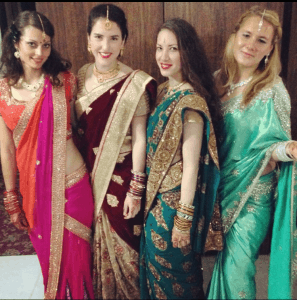Lucknow is the city where Gaurav grew up, and it is where most of his family still lives. It is approximately one hour south of New Delhi by plane, and six hours by car. The first, of many times, that I regretted over-packing for India was when I spotted the miniature jet that would take us from New Delhi to Lucknow. It was only slightly larger than what I had pictured the Magic School Bus to be. But unlike the Magic School Bus, it was not magic – or a cartoon. Furthermore, instead of transporting a small class of first graders, my Magic School Bus would, supposedly, transport me, forty other passengers, my life supply of luggage, and all of THEIR luggage safely into the sky and down to earth again.
I reminded myself that I wasn’t the first person to fly to Lucknow, and with any luck(now!), I hoped I wouldn’t be the last. I took half an Ativan as soon as we boarded the plane and considered slipping the other half to the screaming infant seated behind me. I decided I wouldn’t survive the night in Indian prison if the mother realized I had drugged her baby, so I pocketed the second half for another time. It didn’t occur to me that the sedative would not wear off by the time we landed an hour later, so I do not posses a detailed recollection of the airport in Lucknow or any of my first impressions as we entered into the city. I do, however, remember thinking that Lucknow was “very nice,” but most things are when you’ve taken Ativan.
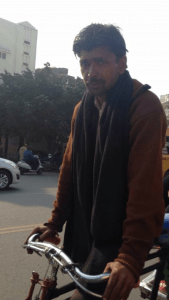
Gaurav had underestimated how many of his American friends would journey to India and attend his wedding. In addition to Gabby, Ezra, and myself, a girl named Rael had also made the trip. Gaurav’s family did not have space in their home for four additional guests on top of the numerous family members visiting from southern India, so his father generously booked two rooms for us at The Best Western Hotel, which was conveniently located in the center of the city.
This Best Western was unlike any Best Western I had encountered in the States. There was a valet service at the entranceway of the hotel, as well as a school of bellboys poised to carry our luggage as we checked into our rooms. The lobby had a fountain and an indoor garden, and it smelled like a mixture of Indian spices. Our concierge was a pleasant young woman who spoke impeccable English with only the slightest hint of an Indian accent. These were the accommodations of a high-end hotel, mispackaged and presented to us under the guise of a mediocre American brand. If this is what they think a Best Western looks like, I thought to myself, Indians know as little about my culture as I know about theirs.
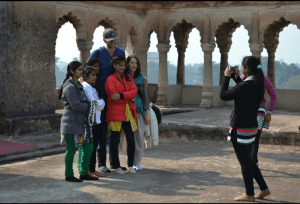
After we checked in, we found Rael, who was already enjoying the Indian version of the Best Western continental breakfast in the formal dining room adjacent to the lobby. A colorful spread of fruits, fresh squeezed juices, and Indian pastries covered the first table. Three hot pans – one vegetarian, one lamb, and one chicken curry were lined in a row on the second table. The third table had a mixture of rice, tandoori meats, soup, and three different variations of naan bread. This continental breakfast was certainly more extensive and also much richer than that which was customary in western chains.
Rael had compiled a perfectly balanced plate of pastries and fresh fruit, and she was seated at a table opposite the buffet. She was very pretty, but she didn’t let on as if she knew. And if she knew, she didn’t let on that she cared. Her long brown hair was twisted into a loose braid and swung carelessly over her left shoulder. Her lips were naturally puffy and pink, glossed without the aid of any artificially-dyed lipstain. She wore olive green gaucho pants, a simple white tank top, and a dyed magenta scarf that she wrapped around her tan shoulders. There were multiple piercings on each of her earlobes and a tattoo of silhouetted birds gliding up the right side of her neck. Her wrists were covered with metal bangles, and the length of her fingers sparkled with rings of all shapes and colors. She personified the Indian aesthetic I had fantasized for myself but had been unable to achieve, no matter how many maxi dresses and pashmina scarves I stuffed into my suitcase.
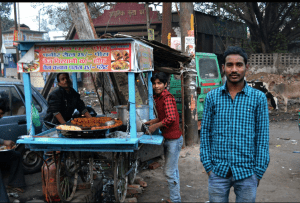
She was very still and used minimal gestures in conversation. She did the majority of her movement through her large brown eyes, which popped from her sockets when she spoke, but remained dormant and half covered by lazy eyelids when she listened. She was happy to receive the company of others, but certainly was not reliant on it. There was power in her silence. It was as if she knew that with the proper amount of patience, the world around her would unravel and reveal itself to her. I was not immune to her spell, and I soon found myself unraveling in her presence. I grasped for her approval by inventing any piece of conversation that I thought might please her.
We learned Rael was a fashion designer who had already planned on touring the textile mills in southern India when Gaurav had invited her to his wedding. She was a close friend of Gaurav’s, but also a keen businesswoman who was seeking cheap fabric for her clothing line. Rael was also a professional photographer. She hoped to capture some images for her book before returning to the States. After the wedding ceremony was finished, Rael planned on spending an extra month in India alone, traveling the rural countryside and establishing relationships with the local textile factories. This information confirmed what I had already suspected to be true: Rael was much, MUCH cooler than I was. She, and not I, was the type of person who drops everything and travels to India. I wondered if it was obvious to her that I was an imposter. If she noticed my inadequacies, she didn’t let on that she had. And if she had, she didn’t let on that she cared.
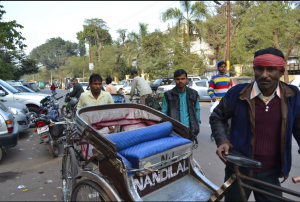
According to Gaurav’s older sisters, Lucknow was the best place for us to purchase Saris before the wedding. Neither Gabby nor I owned a sari, so we were happy to take advantage of this opportunity to go shopping. Of course, Rael had already packed a sari that would be appropriate for the occasion (she owned three), but she was interested in buying another. So after we finished breakfast, the three of us set out to find authentic Indian ensembles to wear at the wedding.
The Best Western was located at the center of Lucknow’s main shopping district. Stepping out of the hotel, we were immediately presented with ample opportunity to spend our money. The street was lined with various sari shops and stores that carried clothing embroidered with “chicken stitch,” a sewing practice that is specific to Lucknow garment manufacturers. Gaurav’s sister recommended one of the larger stores that was located approximately three blocks away from our hotel. When entered the shop, we were immediately swarmed by all the sales associates on the floor. Maybe it was Gabby’s blond hair, or my expression of wonder, that gave us away, but within minutes of arriving, the staff was already showering us with their praise for the American people. Most Americans I know aren’t nearly as great as the Indian people would have you believe, but they were so kind and I didn’t bother to correct them.
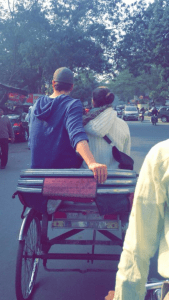
We were swept to the back of the store and seated in a private showing space. They welcomed us with small cookies, tea, and bottle watered. I was overwhelmed by their hospitality and hungry, so I ate two of the cookies. I immediately regretted this decision. Were these cookies a binding promise that I would buy my sari at this store before seeing any others? I expressed my concern to Rael and questioned whether it had been wise for us to accept their offerings of tea and water without considering their ulterior motives. She stared forward, unmoved by our host’s kind gestures, and expressed our “potential interest” in making a purchase.
Both Gabby and Rael had clearly envisioned what their saris would look like. They each provided our salesman with detailed descriptions of their preferences, and I watched in awe as a seemingly endless stream of saris were rushed into the room and piled onto the table before us. Rael masterfully maintained an unimpressed expression as she pealed through the mountain of garments in front of her. Gabby, like myself, had little knowledge of Indian fashion, but she flawlessly hid her ignorance as she feigned a discerning eye. When it came time to express my preferences, it was obvious that I hadn’t considered that there were numerous styles of saris for me to pick from. I grasped for anything I could say that would help narrow down the salesman’s selection. My favorite color is yellow, I told him, not realizing just how stupid this sounded until after the words had left my lips. Without lifting her gaze from the pile of saris in front of her, Rael corrected my mistake. You should never wear yellow, she said. She then instructed our salesman to bring a selection of saris in deep jewel tones.
Experience the Insider community that takes your international lifestyle to the next level. Download your FREE guide
"18 Steps to Implementing Your Plan B" instantly!
I was unable to hide my excitement as the staff filed into our room with arms full of a wide variety of deep-colored saris. My eyes grew as each new garment was added to the pile forming before me. There were chiffon saris and silk saris, two-piece saris and one-piece saris. Some of the saris were one solid color, others had intricate designs. Some saris were embellished with embroidery and beads, while others were sleek with no frills. I was overwhelmed by the options and began to panic. Each sari brought into our room was more beautiful than the last, but undoubtedly less beautiful than the sari that would follow.
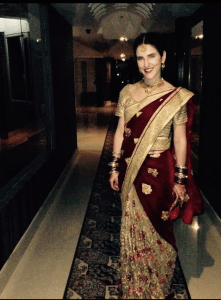
Just when I had resigned myself to an existence of paralyzing indecision from the back of this sari shop (a life that I would comfortably sustain with a diet of small cookies, bottled water, and tea), I was presented with a crimson velvet sari that offered me only one decision. I ran my fingers over the delicate gold flowers that were embroidered along the side of the red velvet cloth, and I knew I had to try it on. I stood on a stool as the salesman wrapped the sari over my clothes and instructed me on proper sari-folding technique. The cloth was much longer than the length needed to wrap my body, and the extra fabric was bunched and pinned in the front so that it flared out around my feet. I looked in the mirror and knew I never wanted to take it off. It would be nearly impossible to walk out from the back of the store without being noticed, so my only option was to pay for it.
It was too late to play it cool now that the negotiations had begun. They told me the price of the sari would be $200, and I quickly agreed. When I told Gaurav how much I had paid, he shook his head and told me it was too much. I paid more money for my fourth prom dress, so his logic made very little sense to me. It seemed like a reasonable price to pay for what was now my favorite possession in the entire world. Needless to say, Rael and Gabby negotiated much better prices for their saris. I hope they will forgive me for saying this, but I didn’t like theirs nearly as much.
We spent the remainder of our day wandering around “chicken” shops and visiting different parts of Lucknow. We took a rickshaw to a park and ate food from surrounding street vendors while we sat in the grass. Our driver got lost on the way back to the hotel, so we were able to take an unofficial and unexpected tour of the city. We drove through a more residential area of the city, where there were less shops and more children roaming the streets. The street was filled with the men, women, and children who presumably resided in the surrounding homes. They shuffled around slowly, making it difficult for our driver to move. We probably would have traveled faster by foot.
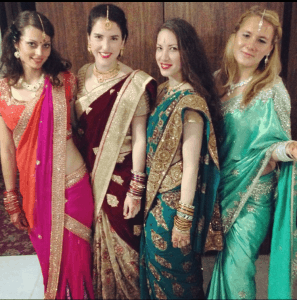
This was the first time I saw a starving child in India. I was aware of the poverty that consumed a large part of the Indian population, but true awareness can only be gained through personal experience. No longer was I thousands of miles removed, clicking through google images on my laptop. I was now inches away from a bony hand at the end of a bony arm that desperately reached towards our rickshaw as we drove by. When I looked down, I saw that the boy was not alone. Just behind him was an even smaller child holding onto his older brother’s emaciated leg. I had no cash, no food, just a pack of gum and some lipgloss. It was a very helpless feeling, knowing that even if I had money or food to give these children, it wouldn’t be enough for the next day or for the next child who couldn’t afford to eat. $200 suddenly felt like too much money to spend on a sari.
It was time for dinner when we made it back to the hotel. We found a small vegetarian restaurant near the Best Western and sat for a quick meal. Gabby, Ezra, and Rael ordered the restaurant’s special, a vegetarian rice dish topped with a spiced chickpea gravy. I had only been in India for a few days, but I was becoming exhausted by spices. I wanted something that felt familiar, so I ordered the veggie burger. I assumed that a culture that didn’t eat cow would have a good solution to the veggie patty, and I definitely considered it something worth trying. It turns out that Best Westerns aren’t the only American tradition Indians are unfamiliar with. Indians are also misinformed as to what constitutes a burger. While my friends enjoyed a delicious meal of chickpeas, I was presented with a bun, lettuce, tomato, and a chunky version of American ketchup. In India, a vegetarian burger is another way of saying “no burger.” I felt silly sending it back since it was stupid for me to order a burger in the first place. I heard my mother’s voice encouraging me to eat the unappealing dish, drawing on the phantom starving children of this world to guilt me into submission. Normally, such tactics are of little use on me, but on this particular night, the starving children didn’t seem as phantom as they had before. I ate the entire “burger” and was grateful for the bun, lettuce, and tomato…even if it wasn’t what I had expected. The chunky ketchup added substance to the sandwich, and it ended up being a very filling dinner.
To be Continued…
Like Our Articles?
Then make sure to check out our Bookstore... we have titles packed full of premium offshore intel. Instant Download - Print off for your private library before the government demands we take these down!

